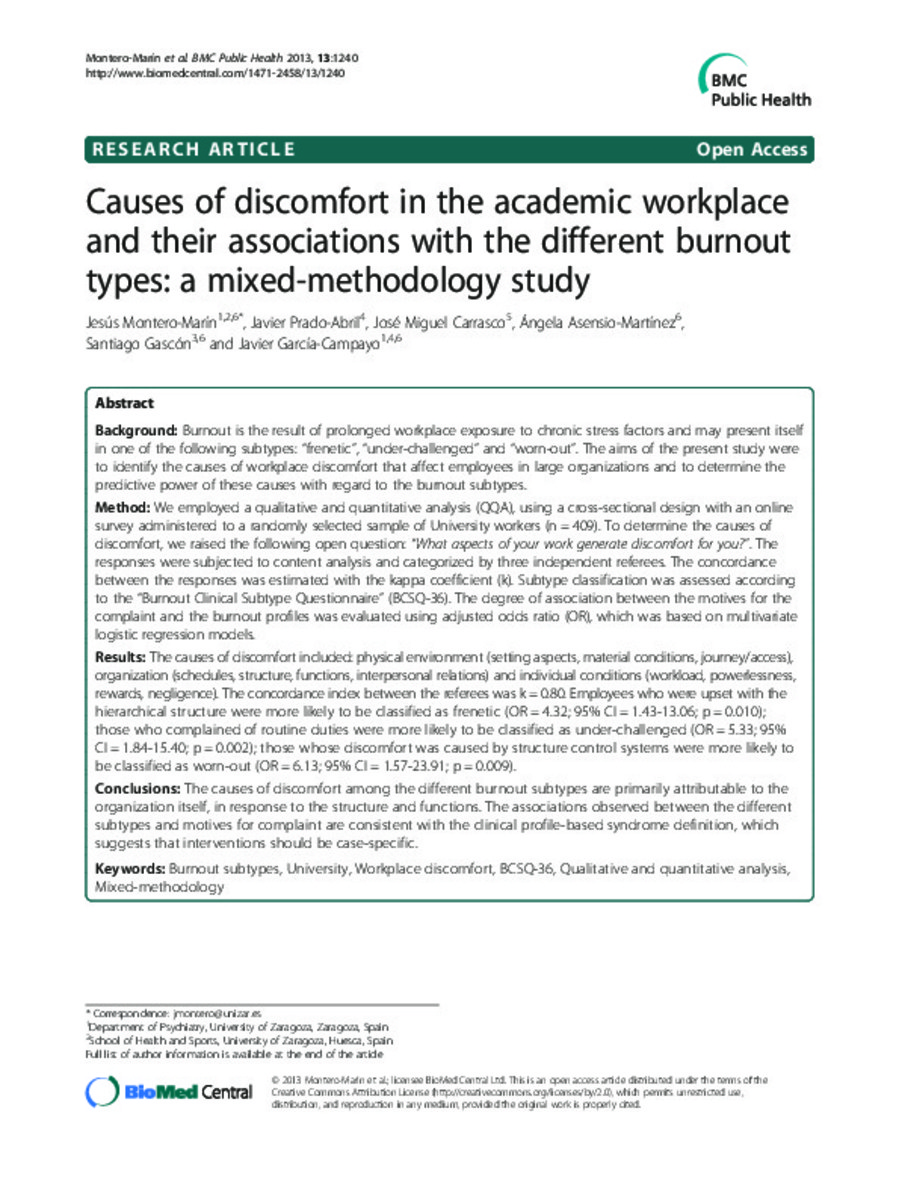Full metadata record
| DC Field | Value | Language |
|---|---|---|
| dc.creator | Montero-Marín, J. (Jesús) | - |
| dc.creator | Prado-Abril, J. (Javier) | - |
| dc.creator | Carrasco-Gimeno, J.M. (José Miguel) | - |
| dc.creator | Asensio-Martínez, Á. (Ángela) | - |
| dc.creator | Gascón, S. (Santiago) | - |
| dc.creator | García-Campayo, J. (Javier) | - |
| dc.date.accessioned | 2018-04-10T07:02:45Z | - |
| dc.date.available | 2018-04-10T07:02:45Z | - |
| dc.date.issued | 2013 | - |
| dc.identifier.citation | Montero-Marín J, Prado-Abril J, Carrasco JM et al. Causes of discomfort in the academic workplace and their associations with the different burnout types: a mixed-methodology study. BMC Public Health 2013 13:1240. | es_ES |
| dc.identifier.issn | 1471-2458 | - |
| dc.identifier.uri | https://hdl.handle.net/10171/50960 | - |
| dc.description.abstract | Background Burnout is the result of prolonged workplace exposure to chronic stress factors and may present itself in one of the following subtypes: “frenetic”, “under-challenged” and “worn-out”. The aims of the present study were to identify the causes of workplace discomfort that affect employees in large organizations and to determine the predictive power of these causes with regard to the burnout subtypes. Method We employed a qualitative and quantitative analysis (QQA), using a cross-sectional design with an online survey administered to a randomly selected sample of University workers (n = 409). To determine the causes of discomfort, we raised the following open question: “What aspects of your work generate discomfort for you?”. The responses were subjected to content analysis and categorized by three independent referees. The concordance between the responses was estimated with the kappa coefficient (k). Subtype classification was assessed according to the “Burnout Clinical Subtype Questionnaire” (BCSQ-36). The degree of association between the motives for the complaint and the burnout profiles was evaluated using adjusted odds ratio (OR), which was based on multivariate logistic regression models. Results The causes of discomfort included: physical environment (setting aspects, material conditions, journey/access), organization (schedules, structure, functions, interpersonal relations) and individual conditions (workload, powerlessness, rewards, negligence). The concordance index between the referees was k = 0.80. Employees who were upset with the hierarchical structure were more likely to be classified as frenetic (OR = 4.32; 95% CI = 1.43-13.06; p = 0.010); those who complained of routine duties were more likely to be classified as under-challenged (OR = 5.33; 95% CI = 1.84-15.40; p = 0.002); those whose discomfort was caused by structure control systems were more likely to be classified as worn-out (OR = 6.13; 95% CI = 1.57-23.91; p = 0.009). Conclusions The causes of discomfort among the different burnout subtypes are primarily attributable to the organization itself, in response to the structure and functions. The associations observed between the different subtypes and motives for complaint are consistent with the clinical profile-based syndrome definition, which suggests that interventions should be case-specific. | es_ES |
| dc.description.sponsorship | Research Network on Preventative Activities and Health Promotion (RD06/0018/0017) | es_ES |
| dc.language.iso | eng | es_ES |
| dc.publisher | BioMed Central | es_ES |
| dc.rights | info:eu-repo/semantics/openAccess | es_ES |
| dc.subject | Burnout subtypes | es_ES |
| dc.subject | Workplace discomfort | es_ES |
| dc.subject | BCSQ-36 | es_ES |
| dc.subject | Qualitative and quantitative analysis | es_ES |
| dc.title | Causes of discomfort in the academic workplace and their associations with the different burnout types: a mixed-methodology study | es_ES |
| dc.type | info:eu-repo/semantics/article | es_ES |
| dc.description.note | This is an open access article distributed under the terms of the Creative Commons Attribution License (http://creativecommons.org/licenses/by/2.0) | es_ES |
| dc.identifier.doi | https://doi.org/10.1186/1471-2458-13-1240 | es_ES |
Files in This Item:
Statistics and impact
Items in Dadun are protected by copyright, with all rights reserved, unless otherwise indicated.






